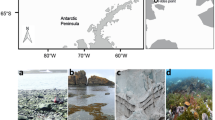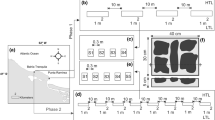Abstract
Species of the genus Jassa are an important element of marine fouling communities, several species often co-occurring on a wide range of hard substrates. At Helgoland (North Sea, German Bight), the cosmopolitan J. marmorata occurs associated with the NW European species J. falcata and J. herdmani. Field and laboratory experiments revealed some ecological differences among species which may facilitate their coexistence. Test panels in the field were instantly colonized by the complete spectrum of resident Jassa species, but J. marmorata proved clearly superior to its congeners in rapidly colonizing new habitats. Further differences among species relate to microhabitat selection (differential use of peripheral and central parts of algal thalli) and the behavioural response to mechanical disturbance.





Similar content being viewed by others
References
Beermann J, Franke H-D (2011) A supplement to the amphipod (Crustacea) species inventory of Helgoland (German Bight, North Sea): indication of rapid recent change. Mar Biodivers Rec 4(e41):1–15
Beermann J, Boos K, Reichert K, Haldin J, Franke H-D (2010) Zeigereigenschaften Makrozoobenthos (MZB)-Helgoland 2009: MZB-Monitoring und Bewertung nach EU-WRRL. State Agency for Agriculture, Nature and Rural Areas of Schleswig-Holstein
Borowsky B (1983) Reproductive behavior of three tube-building peracarid crustaceans: the amphipods Jassa falcata and Ampithoe valida and the tanaid Tanais cavolinii. Mar Biol 77:257–263
Borowsky B (1985) Differences in reproductive behavior between two male morphs of the amphipod crustacean Jassa falcata Montagu. Physiol Zool 58:497–502
Branch GM (1984) Competition between organisms: ecological and evolutionary implications. Oceanogr Mar Biol 22:429–593
Clark RA (1997) Dimorphic males display alternative reproductive strategies in the marine amphipod Jassa marmorata Holmes (Corophioidea: Ischyroceridae). Ethology 103:531–553
Conlan KE (1989) Delayed reproduction and adult dimorphism in males of the amphipod genus Jassa (Corophioidea: Ischyroceridae): an explanation for systematic confusion. J Crust Biol 9:601–625
Conlan KE (1990) Revision of the crustacean amphipod genus Jassa Leach (Corophioidea: Ischyroceridae). Can J Zool 68:2031–2075
Conlan KE (1994) Amphipod crustaceans and environmental disturbance: a review. J Nat Hist 28:519–554
Connell JH (1978) Diversity in tropical rain forests and coral reefs. Science 199:1302–1310
Conradi M, López-González PJ, García-Gómez C (1997) The amphipod community as a bioindicator in Algeciras Bay (Southern Iberian Peninsula) based on a spatio-temporal distribution. Mar Ecol 18:97–111
Dixon IMT, Moore PG (1997) A comparative study on the tubes and feeding behaviour of eight species of corophioid Amphipoda and their bearing on phylogenetic relationships within the Corophioidea. Phil Trans R Soc Lond B 352:93–112
Fenchel TM, Kolding S (1979) Habitat selection and distribution patterns of five species of the amphipod genus Gammarus. Oikos 33:316–322
Franz DR (1989) Population density and demography of a fouling community amphipod. J Exp Mar Biol Ecol 125:117–136
Hardin G (1960) The competitive exclusion principle. Science 131:1292–1297
Harper JL, Clatworthy JN, McNaughton IH, Sagar GR (1961) The evolution and ecology of closely related species living in the same area. Evolution 15:209–227
Havermans C, De Broyer C, Mallefet J, Zintzen V (2007) Dispersal mechanisms in amphipods: a case study of Jassa herdmani (Crustacea, Amphipoda) in the North Sea. Mar Biol 153:83–89
Hill C, Elmgren R (1987) Vertical distribution in the sediment in the co-occurring benthic amphipods Pontoporeia affinis and P. femorata. Oikos 49:221–229
Karez R, Ludynia K (2003) Niche differentiation in habitat and current preference corroborates taxonomic distinction of Jassa falcata and Jassa marmorata (Amphipoda, Crustacea). Estuar Coast Shelf Sci 58:279–292
Kroer N (1986) Distribution and habitat segregation of four species of Idotea (Isopoda) in a Danish fjord. Ophelia 25:199–207
Kurdziel JP, Knowles LL (2002) The mechanisms of morph determination in the amphipod Jassa: implications for the evolution of alternative male phenotypes. Proc R Soc Lond 269:1749–1754
Lancelotti DA, Trucco RG (1993) Distribution patterns and coexistence of six species of the amphipod genus Hyale. Mar Ecol Prog Ser 93:131–141
Nair KKC, Anger K (1979) Experimental studies on the life cycle of Jassa falcata (Crustacea, Amphipoda). Helgol Wiss Meeresunters 32:444–452
Nair KKC, Anger K (1980) Seasonal variation in population structure and biochemical composition of Jassa falcata (Crustacea, Amphipoda) off the island of Helgoland (North Sea). Estuar Coast Shelf Sci 11:505–513
O’Connor RJ, Lamont P (1978) The spatial organization of an intertidal Spirorbis community. J Exp Mar Biol Ecol 32:143–169
Roxburgh SH, Shea K, Wilson JB (2004) The intermediate disturbance hypothesis: patch dynamics and mechanisms of species coexistence. Ecology 85:359–371
Schoener TW (1974) Resource partitioning in ecological communities. Science 185:27–39
Schoener TW (1986) Resource partitioning. In: Kikkawa J, Anderson DK (eds) Community ecology: patterns and process. Blackwell Scientific Publications, Melbourne, pp 91–126
Scinto A, Benvenuto C, Cerrano C, Mori M (2007) Seasonal cycle of Jassa marmorata Holmes, 1903 (Amphipoda) in the Ligurian Sea (Mediterranean, Italy). J Crust Biol 27:212–216
Sexton EW, Reid DM (1951) The life-history of the multiform species Jassa falcata (Montagu) (Crustacea Amphipoda) with a review of the bibliography of the species. J Linn Soc Lond Zool 42:29–91
Skadsheim S (1983) The ecology of intertidal amphipods in the Oslofjord. Distribution and responses to physical factors. Crustaceana 44:225–244
Wilson JB (1990) Mechanisms of species coexistence: twelve explanations for Hutchinson’s ‘paradox of the plankton’: evidence from New Zealand plant communities. NZ J Ecol 13:17–42
Wilson JB (1994) The ‘intermediate disturbance hypothesis’ of species coexistence is based on patch dynamics. NZ J Ecol 18:176–181
Zar JH (1996) Biostatistical analysis, 3rd edn. Prentice Hall, New Jersey
Zintzen V, Norro A, Massin C, Mallefet J (2008) Temporal variation of Tubularia indivisa (Cnidaria, Tubulariidae) and associated epizoites on artificial habitat communities in the North Sea. Mar Biol 153:405–420
Acknowledgments
We are grateful to the crew of the research vessel ‘Aade’ for their help in the field and to Anabel Eulner for her assistance in the laboratory. Karin Boos gave very helpful comments on the statistical analysis of the data. The first author (JB) is financially supported by a scholarship of the Free University of Berlin (Elsa-Neumann-Stipendium of the Federal State of Berlin). Finally, we would like to thank two anonymous reviewers for their constructive comments on the manuscript.
Author information
Authors and Affiliations
Corresponding author
Additional information
Communicated by S. Connell.
Rights and permissions
About this article
Cite this article
Beermann, J., Franke, HD. Differences in resource utilization and behaviour between coexisting Jassa species (Crustacea, Amphipoda). Mar Biol 159, 951–957 (2012). https://doi.org/10.1007/s00227-011-1872-7
Received:
Accepted:
Published:
Issue Date:
DOI: https://doi.org/10.1007/s00227-011-1872-7




